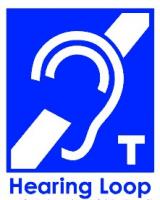Let's Hear Stroud - Legislation
Legislation requirements re Hearing loops
Equality Act 2010
The Equality Act 2010 combines a number of already established laws and states that everyone should be treated equally. Its goal is to protect people from discrimination and improve public services.
The 2010 Act replaced previous ‘anti-discrimination laws’, including the Disability Discrimination Act (DDA), with a single document which empowers the law to tackle inequality situations which have an impact on disabled people. It accounts for age, sex and race.
The Act mentions provision of hearing loops, stating that “Service providers are required to make changes, where needed, to improve service for disabled customers or potential customers… and to provide auxiliary aids and services (such as information in an accessible format, an induction loop for customers with hearing aids).”
For service providers, it is important to note the reference made to “potential customers” to ensure issues are not only addressed within businesses. Environments should be provided which are inclusive and accessible for all. The Act states that service providers are legally required to provide environments of this type.
Part M of the Building Regulations 2010 - Access to and Use of Buildings
“The aim is for all people to have access to, and the use of, all the facilities provided within buildings.” – Section 4.1 of Part M
Part M is an Approved Document by the Department for Communities and Local Government which provides guidance on compliance with building regulations. It states that to obtain the full benefit of situations such as discussions or performances “a person with hearing loss must receive a signal that is amplified in both volume and signal to noise ratio,” and provision must be made for a permanent system in larger spaces.
Hearing Loops: Hearing loops, infrared and radio frequency systems are listed as commonly used solutions. Requirements of Part M are only met if “the presence of an induction [hearing] loop or infrared hearing enhancement system is indicated by the standard symbol,” demonstrating the importance of clear signage in buildings.
Entertainment, Education and Social Venues: Everyone should “be able to participate in the proceedings at lecture/conference facilities and at entertainment or leisure and social venues, not only as spectators, but also as participants and/or staff.” In buildings with entertainment or leisure and conference facilities, a solution such as a hearing loop must be provided to enable people with hearing loss to participate. This applies to hotels, schools, universities and community centres, as well as theatres and sports stadia.
Service and Reception Counters: A solution supporting people with hearing loss must be investigated for all buildings where service or reception counters are found. This includes many types of buildings, i.e. retail, worship, healthcare, transport, government and education.
Locations: It is not often sufficient to just address one area. When trying to meet the requirements laid out in Part M, it is important to consider that there may be many locations within a building where conversations or listening interactions take place. Focus on providing a good customer experience instead of simply providing the minimum required to comply with the regulations.
BS 8300 - Buildings Code of Practice 2018
BS 8300 is a code of practice compiled by the British Standards Institution detailing the required design of buildings for meeting the needs of disabled people, and promotes equal access to services and buildings.
Whether you’re an architect, tender manager, store fit out provider, retailer or designer, the revised 2018 BS 8300 provides greater clarity on the appropriate level of provision and installation for hearing loops. It also heavily influences European and US standards.
Hearing Loops
A complete annex is included within the BS 8300-2 standard detailing hearing loop requirements. This annex covers hearing loop specifications, provisions, location variations, applications, best practice installation and maintenance, and staff testing and training.
BS 8300 also gives guidance on where hearing loops should be used, such as at help and refuge points, meeting rooms, halls, public sector buildings, cinemas, sporting venues, anywhere with points of sale and many more locations. It also provides instruction for microphone inputs and the various sound sources that can be selected for applications.
Specialists & Maintenance Required
There is a requirement for reactive and preventative maintenance of hearing loop systems using a provider with “specialist knowledge.” Staff training should be given to ensure staff knowledge of hearing loops, ensuring they can engage with individuals with hearing loss, and there should also be proactive staff testing using an appropriate testing meter.
 Contact Martyn Harwood about this page:
Contact Martyn Harwood about this page:
Related pages...
Let's Hear Steeing Group
more Local Agencies that are supporting Let's Hear Stroud

Let's Hear Stroud - Information
more Information about Let's Hear Stroud Why should I have a Hearing Loop and what type is best for your business.
Loop Checkers Needed
more We need volunteers to help check Hearing loops in Stroud
Volunteer Loop Checker
more Role Description
Who are Let's Hear Stroud Volunteers?
more A team of volunteers working with Stroud Rotary to make a difference in their community
How do I join Let's Hear Stroud
more Email the following information to hearing@stroudrotary.org.uk and we will be in touch
back to page above this...

Let's Hear Stroud - SUSPENDED DUE TO COVID
back The Let’s Hear Stroud campaign aims to enhance hearing in public places by empowering local people to improve hearing experiences for themselves and other hearing aid users when visiting high street retailers, banks, council offices, cinemas, churches etc